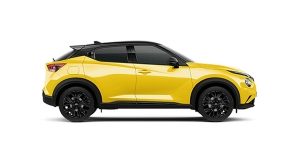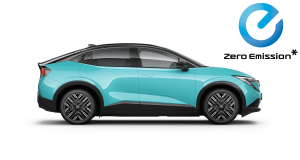Switching to an electrified vehicle doesn't have to be a big step.
Switching to an electrified vehicle doesn't have to be a big step.
With a range of electrification options,
there’s a vehicle
that's perfect for you.
Switching to an electrified vehicle doesn't have to be a big step.
With a range of electrification options, there’s a vehicle that's perfect for you.

Mild Hybrid, optimising efficiency
Mild Hybrid cars are the easiest way to switch to electrification. A petrol engine drives the wheels while an electric battery provides support during acceleration, up hills and while cruising. The only change you’ll notice is improved fuel efficiency and a more comfortable drive — particularly in stop-start traffic.

Hybrid, a thrilling electrified experience
Hybrid vehicles add an electric motor to your everyday petrol engine to bring you many of the benefits of electric, without the need to charge. The system seamlessly switches between electric, combustion, or a combination of the two, automatically applying the most efficient driving solution.

e-POWER, your first step towards going Electric
e-POWER combines a petrol engine which charges the battery with an electric motor that turns the wheels. e-POWER has lower emissions and running costs compared to a traditional petrol engine [2], but unlike a fully electric vehicle, you don't have to plug it in. There is also no compromise in terms of driving pleasure, e-POWER delivers instant acceleration giving you that Electric Vehicle feeling.

100% Electric, driving the future
Powered by an electric motor and battery pack, you'll never need to visit the petrol station again. Electric power is clean, silent, efficient and cheaper, but you do need to charge, which may mean planning long journeys and installing a charging point at home.
Our electrified options at a glance
Our electrified options at a glance
Our electrified options at a glance
| MILD HYBRID |
HYBRID |
e-POWER |
100% ELECTRIC |
|
|---|---|---|---|---|
| How it works | A petrol engine is supported by a battery during acceleration and cruising | Powered by a combination of petrol engine and an electric motor |
A combination of petrol engine which charges the battery and an electric motor that turns wheels |
Entirely powered by an electric motor using a battery |
| What powers the wheels? | Petrol engine | Petrol engine, electric motor or both. |
Electric motor | Electric motor |
| How is the battery charged? | Charges while driving through regenerative braking | Charges while driving by the combustion engine and regenerative braking |
Charges while driving by the combustion engine and regenerative braking |
Must be plugged in to charge |
| Does it need petrol? | Yes | Yes |
Yes | No |
| What is the driving experience? | Torque assist with responsive acceleration | Instant torque and a quieter drive |
Instant torque and a silent drive | Instant torque and a silent drive |
| CO2 emissions | Lower tailpipe emissions than an equivalent model, with a traditional petrol engine [1] |
Significantly reduced emissions [2] |
Lower tailpipe emissions than an equivalent model with Mild hybrid [2] |
Zero-tailpipe emissions [1] |
| How much of the time does the car run on 100% electric? | 0% | 67% [3] |
100% | 100% |
| MILD HYBRID |
HYBRID |
e-POWER |
100% ELECTRIC |
|
|---|---|---|---|---|
| How it works | A petrol engine is supported by a battery during acceleration and cruising | Powered by a combination of petrol engine and an electric motor |
A combination of petrol engine which charges the battery and an electric motor that turns wheels |
Entirely powered by an electric motor using a battery |
| What powers the wheels? | Petrol engine | Petrol engine, electric motor or both. |
Electric motor | Electric motor |
| How is the battery charged? | Charges while driving through regenerative braking | Charges while driving by the combustion engine and regenerative braking |
Charges while driving by the combustion engine and regenerative braking |
Must be plugged in to charge |
| Does it need petrol? | Yes | Yes |
Yes | No |
| What is the driving experience? | Torque assist with responsive acceleration | Instant torque and a quieter drive |
Instant torque and a silent drive | Instant torque and a silent drive |
| CO2 emissions | Lower tailpipe emissions than an equivalent model, with a traditional petrol engine [1] |
Significantly reduced emissions [2] |
Lower tailpipe emissions than an equivalent model with Mild hybrid [2] |
Zero-tailpipe emissions [1] |
| How much of the time does the car run on 100% electric? | 0% | 67% [3] |
100% | 100% |
| Mild hybrid POWER |
e-POWER |
100% Electric POWER |
|
|---|---|---|---|
| How it works | A petrol engine is supported by a battery during acceleration and cruising | A combination of a petrol engine which charges the battery and an electric motor that turns the wheels | Entirely powered by an electric motor using a battery |
| What powers the wheels? | Petrol engine | Electric motor | Electric motor |
| How is the battery charged? | Charges while driving through regenerative braking | Charges while driving by the combustion engine and regenerative braking | Must be plugged in to charge |
| Does it need petrol? | Yes | Yes | No |
| What is the driving experience? | Torque assist with responsive acceleration | Instant torque and a silent drive | Instant torque and a silent drive |
| CO2 emissions | Reduced emissions | Minimal emissions | Zero emissions |
Our powertrains models
Our powertrains models
Our powertrains models
Mild Hybrid

Hybrid

e-POWER

100% Electric

Legend
Legend
LEGEND
 Transmission Transmission |
 Combustion engine Combustion engine |
 Electric motor Electric motor |
 Battery Battery |
 Inverter Inverter |
 Generator Generator |
 Transmission Transmission |
 Combustion engine Combustion engine |
 Electric motor Electric motor |
 Battery Battery |
 Inverter Inverter |
 Generator Generator |
 Transmission Transmission |
 Combustion engine Combustion engine |
 Electric motor Electric motor |
 Battery Battery |
 Inverter Inverter |
 Generator Generator |
e-4ORCE all-wheel drive
It's not the power, it's how you use it. e-4ORCE technology unlocks the full potential of electrified driving, sending power to the right wheels at the right time for incredible control and comfort, no matter the terrain. Available with New Nissan Ariya and New Nissan X-Trail

Discover our full range of cars
Discover our full range of cars
Discover our full range of cars

Experience the electrified thrill
Experience the electrified thrill
Experience the electrified thrill

JUKE
The compact crossover
An original attitude. Updated. Next generation Nissan Juke Hybrid has been designed with boldness at its heart, new details that catch every eye and intelligent safety systems [5].

QASHQAI
The compact crossover
The ultimate crossover, with e-POWER coming soon. Pioneering the crossover segment in 2007, the Nissan Qashqai has remained a fan favourite due to its advanced technology, dynamic performance typical of a hatchback, and practical as well as desirable SUV-styling. Available soon.

X-Trail
The electrified 5-7 seater, fit for family adventures
The comforting crunch of sticks and leaves beneath your wheels sounds the start of a new family adventure, and with 5–7 seats in the Nissan X-Trail, it's one even the biggest families can enjoy.

ARIYA
The 100% electric coupe crossover.
The 100% electric coupe crossover. The ARIYA crossover with optional e-4ORCE technology is the start of a new era of seamless, intuitive and adaptive experiences both onboard and offboard. All packaged in a sophisticated exterior design inspired by timeless Japanese futurism. Available in Summer 2022.
The Nissan sustainability cycle
The Nissan sustainability cycle
The Nissan sustainability cycle


Sustainable production
Production is our largest emissions source, but we're working hard to reduce it. The solar roof at the Nissan Motor Parts Centre in Amsterdam produces 70% of the centre’s annual energy needs, with excess energy delivered back into the national grid.

Driving towards zero emissions
With over 500,000 Nissan LEAFs sold worldwide, and new models to suit all lifestyles, zero-emission vehicles will continue to play a big role in Nissan's future. Today we're forging partnerships with national and local governments, other companies and other industries to help secure the necessary infrastructure for a zero-emission future.

Renewable energy
One of our main priorities is to make the electric car lifecycle sustainable from before to after the life of the vehicle. Refurbished Nissan batteries are reused for energy storage in buildings, like solar powered homes and the Johan Cruijff Arena in Amsterdam. The largest of its kind in Europe, it stores enough electricity to power the entire neighbourhood around the stadium.
[1] Based on WLTP figures, compared to equivalent model combustion engine. Real world driving results may vary, depending on multiple factors such as opptional equipment, battery condition, climate control, maintenance, driving behaviour and non-technical factors like weather conditions , actual route etc
[2] Based on internal testing data,and pending homologation. Real world driving results may vary, depending on multiple factors such as optional equopement, battery condtion, climate control, maintenance, driving behavioiur and non-technical factors like weather conditions, actual route etc.
[3] Hybrid Electric Vehicle descriptions use comparison against the equivalent combustion engine model. Juke Hybrid WLTP cycle pending official homologation in 2022. WLTP figures shown are for comparability purposes. Actual real-world driving results may vary depending on factors including the starting charge of the battery, accessories fitted after registration, weather conditions, driving styles and vehicle load.
[4] Figure of 67% for electric mode driving is based on internal testing, using similar WLTP standard testing conditions. Figures shown are indicative and for comparability purposes. Actual real-world driving results may vary depending on factors including the starting charge of the battery, accessories fitted after registration, weather conditions, driving styles and vehicle load.
[5] You should not rely solely on driver convenience features. Some features may not work in all conditions and circumstances. Speed and other limitations apply. For terms and conditions relating to Nissan technologies. Safety features vary depending on grade, for more information speak to your local dealer.
[6] Retail customers only, subject to availability. Includes used cars. The offer cannot be used in conjunction with any other offer. Nissan Financial Services subject to status. Customers must be 18+, T&Cs apply. For further details please speak with your participating dealer.
Images and descriptions shown are for guidance purposes. In some instances, photos are of non-CY specification vehicles and do not represent a specific model, grade or offer. The features shown may be available as standard or only as an option (at an extra charge).








